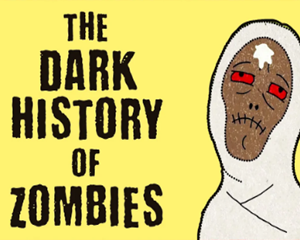Animated corpses appear in stories all over the world throughout recorded history.
在世界各地的故事中,都有会动的尸体,和历史一样渊远流长。
But zombies have a distinct lineage -- one that traces back to Equatorial and Central Africa.
但僵尸有自己的传承:故事要从非洲邻近赤道地区及中非说起。
The first clue is in the word "zombie" itself. Its exact etymological origins are unknown, but there are several candidates.
第一个线索,就在僵尸这名字里面。正确的词源已不可考,但有数种可能。
The Mitsogho people of Gabon, for example, use the word "ndzumbi" for corpse.
例如,加蓬共和国的米兹博人,用“ndzumbi”指称尸体。
The Kikongo word "nzambi" refers variously to the supreme being, an ancestor with superhuman abilities, or another deity.
刚果语中的“nzambi”则用以描述至高无上者,像是拥有超人能力的祖先,或是其他神明。
And, in certain languages spoken in Angola and the Congo, "zumbi" refers to an object inhabited by a spirit, or someone returned from the dead.
而在安哥拉和刚果的几种语言中,“zumbi”的意思是“被灵魂附身的某物”,或是“从死亡归来之人”。
There are also similarities in certain cultural beliefs.
许多特定文化的信仰也有相似之处。
For example, in Kongo tradition, it's thought that once someone dies, their spirit can be housed in a physical object which might bring protection and good luck.
例如,在刚果的传统中,人们相信如果某人去世,他的灵魂可以寄宿在物体上,这个物体可能带来保护或好运。
Similar beliefs about what might happen to someone's soul after death are held in various parts of Africa.
在其他许多非洲地区,也都能发现相似的亡魂归处信仰。
Between 1517 and 1804, France and Spain enslaved hundreds of thousands of African people, taking them to the Caribbean island that now contains Haiti and the Dominican Republic.
在1517年和1804年之间,数十万非洲人被法、西两国抓为奴隶,被带至加勒比海,包含现今的海地和多米尼加共和国。
There, the religious beliefs of enslaved African people mixed with the Catholic traditions of colonial authorities and a religion known as "vodou" developed.
在那里,这些被奴役的非洲人的信仰,和殖民政府的天主教传统混合,创造出名为“巫毒”的宗教。
According to some vodou beliefs, a person's soul can be captured and stored, becoming a body-less "zombi."
根据某些巫毒信仰,我们可以抓捕、储存人的灵魂,让它们成为没有身体的“僵尸”。
Alternatively, if a body isn't properly attended to soon after death,
相对地,如果在死后尸体没有获得迅速且合宜的处置,
a sorcerer called a "bokor" can capture a corpse and turn it into a soulless zombi that will perform their bidding.
称为“波戈”的巫师就能俘虏尸体,把它变成没有灵魂、听从指令的僵尸。
Historically, these zombis were said to be put to work as laborers who needed neither food nor rest and would enrich their captor's fortune.
根据历史纪录,这些僵尸被当成工人使用,它们不需吃喝,不需休息,因此会使主人更加富裕。
In other words, zombification seemed to represent the horrors of enslavement that many Haitian people experienced.
换句话说,僵尸化似乎反映了奴役的可怕,而这是许多海地人都曾经历过的。
It was the worst possible fate: a form of enslavement that not even death could free you from.
这是最悲惨的命运:连死亡也无法让人从奴役中解脱。

The zombi was deprived of an afterlife and trapped in eternal subjugation.
僵尸被剥夺来世,永远受人控制。
Because of this, in Haitian culture, zombis are commonly seen as victims deserving of sympathy and care.
因此,在海地文化中,僵尸常被当作值得同情和关心的受害者。
The zombie underwent a transformation after the US occupation of Haiti began in 1915 -- this time, through the lens of Western pop culture.
直到1915年美国占领海地后,僵尸的形象才逐渐转变,这一次变身为西方流行文化眼中的僵尸。
During the occupation, US citizens propagated many racist beliefs about Black Haitian people.
在占领期间,美国公民散播许多针对海地非裔人口的歧视言论。
Among false accounts of devil worship and human sacrifice, zombie stories captured the American imagination.
在崇拜恶魔和活人祭祀等错误描述中,僵尸的故事让美国人相当感兴趣。
And in 1932, zombies debuted on the big screen in a film called "White Zombie."
1932年,僵尸初次登上大屏幕,在《白色僵尸》中堂堂登场。
Set in Haiti, the film's protagonist must rescue his fiancée from an evil vodou master who runs a sugar mill using zombi labor.
故事发生在海地,男主角必须从邪恶的巫毒大师手上救出未婚妻,而这位法师也是个奴隶主,奴役僵尸来经营糖厂。
Notably, the film's main object of sympathy isn't the enslaved workforce, but the victimized white woman.
值得注意的是,获得同情的主要角色并非被奴役的僵尸,而是受害的白人女性。
Over the following decades, zombies appeared in many American films, usually with loose references to Haitian culture, though some veered off to involve aliens and Nazis.
在其后的数十年,僵尸出现在许多美国电影中,只松散地与海地文化联结,有些僵尸甚至跟外星人或纳粹为伍。
Then came the wildly influential 1968 film "Night of the Living Dead,"
接着,在1968年,极具影响力的《活死人之夜》上映,
in which a group of strangers tries to survive an onslaught of slow-moving, flesh-eating monsters.
故事叙述一群陌生人试图在一群移动缓慢、吃人怪物蜂拥而来中存活下来。
The film's director remarked that he never envisioned his living dead as zombies.
电影导演表示,他从没将自己的活死人视为僵尸。
Instead, it was the audience who recognized them as such.
是观众自己如此认为。
But from then on, zombies became linked to an insatiable craving for flesh -- with a particular taste for brains added in 1985's "The Return of the Living Dead."
但从那时开始,僵尸就被加上对血肉的永恒渴望,1985年的电影《活死人归来》还为他们新增了喜爱大脑的饮食口味。
In these and many subsequent films, no sorcerer controls the zombies; they're the monsters.
在这些及后续推出的电影中,已不再出现控制僵尸的巫师,僵尸本身就是怪物。
And in many iterations, later fueled by 2002's "28 Days Later," zombification became a contagious phenomenon.
在许多老调重弹的电影中,2002年的《28天毁灭倒数》带头将僵尸化变成会传染的现象。
For decades now, artists around the world have used zombies to shine a light on the social ills and anxieties of their moment
这几十年来,世界各地的艺术家都用僵尸的形象凸显所处社会的弊病与焦虑,
from consumer culture to the global lack of disaster preparedness.
从消费文化到全球缺乏灾害准备皆是讨论议题。
But, in effect, American pop culture also initially erased the zombies origins -- cannibalizing its original significance and transforming the victim into the monster.
然而,美国的流行文化一开始便把僵尸的起源抹消了:真正的僵尸被美国僵尸蚕食殆尽,而受害者也成了怪物。











